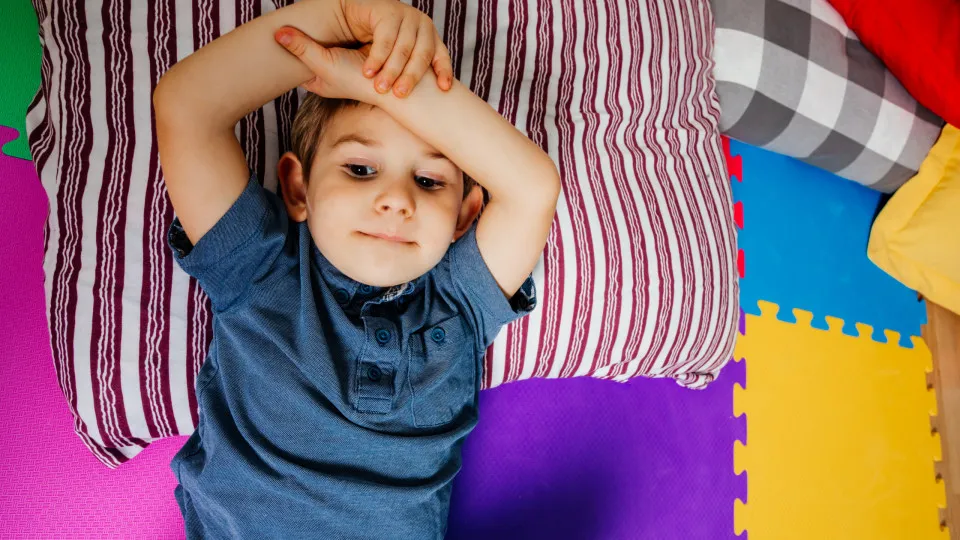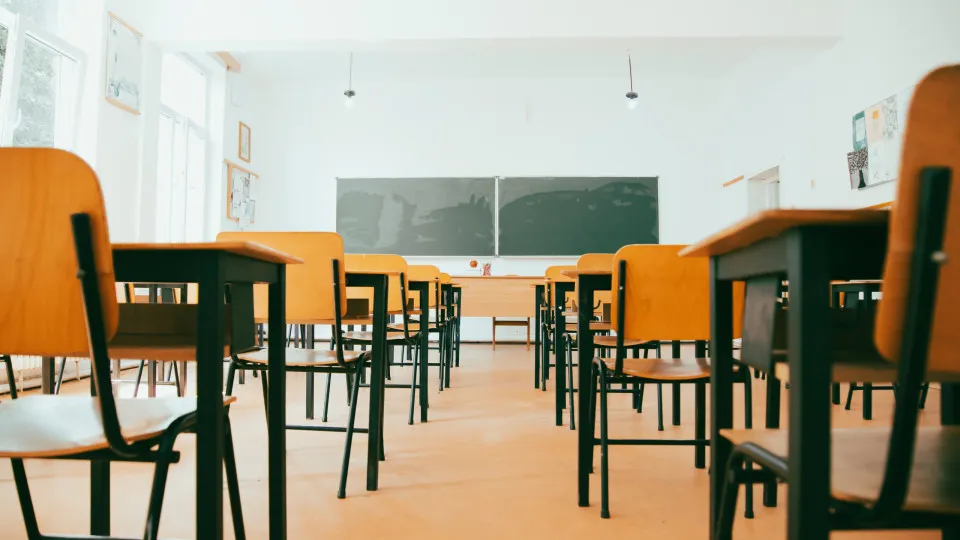
Naps in kindergarten are more than just a rest period; they have become a point of contention between children’s developmental needs and the structural limits of educational institutions.
Experts warn about the negative effects of depriving children up to the age of six of daytime sleep—especially for those who need it—while schools claim they lack the resources to provide naps starting at age three. Some even cite a nonexistent directive, as confirmed by the Ministry of Education to Notícias ao Minuto.
The government indicates that guidelines on this matter are flexible, and the responsibility for accommodating individual children’s needs falls on the preschools themselves.
The blame game has persisted for years, despite multiple discussions on the topic. Meanwhile, children in preschool are not getting the rest they need, affecting family routines, learning, socializing, and play. The consequences might extend to future issues, including sleep disorders and other health concerns, potentially requiring medication. Currently, many families are desperate for solutions.
When Rest Conflicts with the School Routine
Notícias ao Minuto has received numerous complaints from parents upset that their preschool-aged children cannot nap in public schools, whereas naps are generally provided in Private Social Solidarity Institutions (IPSS) and private nurseries.
Parents feel “helpless,” with children becoming more irritable and unstable, often arriving home between 5 p.m. and 6 p.m. already asleep, too exhausted to eat dinner or bathe.
Lack of Naps “Compromises Children’s Development”
Since 2017, when the Portuguese Society of Pediatrics issued recommendations on naps and highlighted the various negative effects of daytime sleep deprivation, the issue gained public and political attention.
In 2019, the Assembly of the Republic formally requested the government to ensure that children aged 3 to 5 could nap at school. However, this still hasn’t materialized, “compromising the development of children,” pediatrician Manuel Magalhães noted in his podcast episode on naps, A Mensagem do Pediatra.
“At age 3, 90% of children need naps. At 4, 60% still require naps. By age 5, 30% continue to benefit from napping, and at 6, 10% could still benefit from naps. These figures highlight the importance of providing naps in Portuguese nurseries until children begin primary school,” explains the health professional with over 231,000 Instagram followers.
“A Fundamental Biological Need”
Psychologists Filipa Malo Franco and Tânia Correia argue that this shouldn’t be an issue because naps are “a fundamental biological need.” While it’s important to consider the “variability” between children, most need to rest during the day.
“There’s considerable variability between children that must be respected. But we know that until age 5 or 6, children who miss their nap are often very dysregulated in the late afternoon. They show behavioral changes, struggle to self-regulate, throw more tantrums, and may even become aggressive. They hit more, become more aggressive, and have less impulse control. These are all signs that the child still needs a nap,” explains Filipa Malo Franco, a pediatric sleep specialist, in an interview with Notícias ao Minuto. She is, however, empathetic toward schools.
“I understand that, from an institutional standpoint, it’s easier to create a standard behavior pattern. I understand that it’s not very practical, at an institutional level, to have some children napping and others not in the same classroom. I understand this can create some disruption and that resources are needed to separate children who want to sleep from those who don’t. Nevertheless, we should protect children and their well-being, which isn’t what’s happening here,” she stresses.
Tânia Correia holds a similar view. For the founder of Clinic 3 M’s, “naps depend more on the child’s needs than their age,” so it’s crucial to “evaluate each child’s best interests.” This, however, is not happening.
Naps Are Not a Luxury but a “Basic Necessity”
Tânia Correia’s experience suggests that requests for naps by parents are still seen as “a demand by a few or an overprotection of children,” which hinders the search for solutions, even in newer institutions with more space and resources.
“Reports to my clinic often reflect a significant indifference—or attempts to blame the parents—accusing them of overprotecting the child and not allowing them to grow. There’s confusion between sleep and autonomy. Everything gets lumped together, and parents are told the problem is their refusal to let the child grow and be independent. Sleep isn’t a behavioral issue; it’s developmental and must be carefully managed,” the psychologist highlights to Notícias ao Minuto.
Consequences in the Short, Medium, and Long Term
Experts agree that naps are “extremely important,” crucial for growth, with severe short, medium, and long-term consequences for children who need them and don’t get them.
“One clear benefit is emotional regulation, which significantly relies on this sleep period that acts as a cognitive restart, organizing some of the day’s experiences. From this rest point, children gain the resources to process emotions, organize them, and be open to establishing relationships,” explains Tânia Correia, also a mother of three girls.
“A severely tired child can’t be open to social connections because they are in survival mode due to sleep being a basic need. Their internal system is more concerned with primitive survival responses than opening up to form relationships or experiment,” she warns, emphasizing the impact of a lack of naps on learning.
“Everyone knows that learning isn’t the same when tired as when awake. Attention, concentration, problem-solving capacity—all these processes require energy and resources, often derived from both nighttime sleep and naps.” she reminds.
This deprivation has tentative effects not only short-term but also mid-to-long-term, warns pediatric sleep specialist Filipa Malo Franco, who boasts over 102,000 Instagram followers.
“Studies strongly associate this with problems consolidating memory and learning. This isn’t just about short-term memory; it affects long-term memory too. It increases attention difficulties, distraction, and diminishes a child’s focus and calmness. They become overstimulated and move a lot since some try to self-regulate through movement when too tired. Long-term studies also relate this to poorer academic performance. Children who didn’t get enough sleep perform worse in language and executive functions, for instance.”
Moreover, she cautions, “there’s the physical, metabolic, and hormonal aspect too,” connected to children sleeping less than necessary.
Pediatrician Manuel Magalhães clarifies these physical health concerns to Notícias ao Minuto, stating: “There’s an association between poor sleep patterns and potential organic changes, including in endocrine and immune functions over the long term. These are long-term issues that can even manifest into adulthood.”
“The most thoroughly studied link is with body mass index and obesity. Children aged 3, 5, and 9 who sleep poorly have a higher likelihood of becoming overweight adults. Obesity increases cardiovascular issues, such as glucose metabolism changes, diabetes, and hypertension, with a strong association here. These metabolic, hormonal, and hypertension changes are tightly linked to sleep because it’s during sleep that metabolism rebalances, crucial for control. Such issues may not arise in childhood but will show in adulthood,” explained the physician, who runs the popular Instagram account O Pediatra.
Tânia Correia alerts about sleep issues, affecting over half of Portuguese people, possibly amplified by denying children naps in preschool.
“In clinic, we’ve discovered that poor adult sleep patterns often stem from learned endurance during childhood. These individuals struggled to fall asleep as teenagers and continue to struggle as adults,” she reveals.
Warning Signs: More Aggressive, Violent, and Anxious Children
Early exclusion of naps doesn’t result in more autonomous children, as some claim, but potentially serious growth issues, plus visible problems such as extreme exhaustion and dysregulation after school.
“One sign is increased reactivity and physical aggression. Some children even become violent and have significant relational difficulties with peers. Children suddenly appear more mature but start biting or hitting friends. They struggle with learning, concentrating, and completing simple classroom tasks, resist adult interactions, and reject directives,” describes Tânia Correia, who has nearly 35,000 Instagram followers.
Additionally, some children become more anxious. “They develop stomach aches, headaches, and sometimes vomit. They resist going to school—not because school itself is stressful, but because they associate it with a draining environment,” the psychologist notes.
At Filipa Malo Franco’s clinic, exasperated parents arrive with “visibly irritated,” “very grumpy” children who fall asleep in the car at 4 or 5 p.m., making “bathing or dining agonizing, eliminating quality family time.”
“This situation bears emotional and relational implications too, as quality family time is crucial for happiness. Children need to feel uplifted, ready to play, and open to bond. But exhaustion causes reactivity. When sleep deprivation occurs, children are often seen hitting, screaming frequently, and throwing excessive tantrums,” the psychologist explains, highlighting the impact of fatigue on the nervous system and emotional regulation capabilities.
“When they nap [on weekends, vacations], this behavior vanishes, making intervention necessary for a more relaxed day,” she uncovers.
The notion that nighttime sleep compensates for nap deficits is also categorically refuted by both psychologists interviewed by Notícias ao Minuto. “Night and day sleep serve different purposes,” stresses Filipa Malo Franco, adding “extreme tiredness often leads to quicker sleep onset, but it frequently results in lower-quality, more fragmented night sleep.”
Tânia Correia observes that “contrary to popular belief, overtiring a child results in poorer sleep. In many cases, overstimulation becomes an unstoppable train. The child struggles to stop, no matter how exhausted. When finally stopping, they collapse from exhaustion. Yet to reach this point, many resist sleep intensely.”
The “Herd Effect” Problem
Though they recognize standard behavior pattern benefits in institutions, experts conversing with Notícias ao Minuto insist “logistical difficulties can’t justify depriving a basic need.”
Schools, overwhelmed by “overcrowded” classes and insufficient adults (nursery teachers and assistants), create what Filipa Malo Franco terms the “herd effect”: “Everyone follows the same pattern because it’s the only way to manage 20+ three, four, or five-year-olds with one or two adults.”
“I feel most schools genuinely care for children and want the best for them. But they’re overcrowded, and educators, assistants, and school adults often do their best with available resources. The foundational lack of resources definitely impacts,” she mentions, urging transformation. Changing the “educational base method,” enhancing “resources, infrastructure, the number of school staff, and reducing class sizes.
“Alleviate this school overcrowding,” she concludes.
A Relaxation Moment Solution?
The ideal solution—two rooms, one for rest and another for activities—seems almost unreachable. Practices like forcing all children to lie in darkness for extended periods or having older children moved to the baby room “are ineffective and even counterproductive,” thus discouraged.
Perhaps instating a post-lunch relaxation break, as pediatrician Manuel Magalhães proposes in his podcast, might suffice.
“Daily rest opportunities should be offered to preschool-aged children allowing naps, should they wish, since children differ. This isn’t about obligation but opportunity […]. Schools ought to provide the means, such as milk, mattresses, a tranquil, dark environment with suitable temperature, noise limitations, and adequate supervision for all preschool-aged children to ensure nap quality. Organizing this napping facility might also cultivate a calm environment. Imagine placing all children in such a setting post-lunch, a calm zone. A daily calm time where children could decide: I want to rest here quietly without wanting to nap, or I can nap,” suggests the doctor, who also teaches.
Magalhães encounters “children coming into the consultation at 4 or 5 years old, physically needing naps—for their regulation, as they’re far angrier without naps—who refuse because their friends play during recess.” This could “easily be resolved with a 1 or 1.5-hour calm moment, beneficial to all, napping or not.”
He recommends, alongside psychologists Tânia Correia and Filipa Malo Franco, establishing “individual nap plans for each child, agreed upon with the family,” and promoting naps by nursery teachers and school representatives rather than treating them negatively, as naps aren’t negative, they’re beneficial.
What Should Parents Do?
Hoping for this implementation in schools, parents are seeking counsel from pediatricians and psychologists. Some request declarations to “create pressure” on school management, while others campaign for awareness actions promoted by Filipa Malo Franco, armed with her experience and “scientific evidence” along with legislation that doesn’t prohibit school naps.
If this doesn’t work, families must adapt for their child’s well-being.
“First, empathize with the child suffering. No punishments, and adjust home routines. Advance dinner and bath times to manage extreme exhaustion,” emphasizes the psychologist, reiterating that true change should involve “structural shifts in the educational system,” like “increasing staff, raising sleep awareness among educators and assistants, reducing class sizes, and considering each child’s uniqueness.”
Absent these, parents are left “handcuffed,” having to make tough choices, as Tânia Correia shared with Notícias ao Minuto.
“Some parents have reached the point of taking leaves up to their child’s age of 12 to work part-time as it’s the only way they can spend more time with their child. Desperation pushes some to this extent as it’s impossible to connect with exhausted children after school,” says the psychologist.
As for the children, Filipa Malo Franco notes they “adapt,” being “incredible,” but their present and future remain affected by something preventable at minimal expense.
“Sleep Is an Essential Biological Need in Child Health”
The experts that spoke to Notícias ao Minuto align with the Portuguese Society of Pediatrics (SPP) and “international scientific consensus.” “Sleep is an essential biological necessity and a pillar of child health,” the SPP emphasizes in its 2017 document containing nap recommendations for children in public or private nurseries and kindergartens.
SPP guidelines emphasize prioritizing individual children’s needs, basing nap decisions on observed behavior and fatigue signs (tantrums, irritability, concentration difficulties) rather than age-based institutional rules.
The society subscribes to recommendations that children aged 3 to 5 require 10 to 13 hours of total daily sleep (including naps) and underscores that educational institutions must provide a suitable, secure rest environment for children displaying such a need, as stipulated in the Family Support Component.
The document stresses that daytime sleep is crucial for memory consolidation and learning new information acquired during the morning, with its deprivation potentially detrimental to cognitive development.
In essence, the Portuguese Society of Pediatrics echoes the parents’ and specialists’ calls, advocating that while structural resource shortages endure, child development shouldn’t be sacrificed for logistical convenience.
“No Legal Regulation for Naps,” Education Ministry Assures
The Notícias ao Minuto queried the Ministry of Education about public school nap guidelines, and Fernando Alexandre’s office verified that “there’s no legal regulation of naps in kindergarten due to varying children’s sleep needs, based on children’s characteristics and their familial routines, thus standard rules are impractical for all cases.”
Thus, “when naps are needed, regardless of age or group inclusion, it’s the educational institution’s duty to create the required conditions within their regulatory framework, in cooperation with families.”
Moreover, the government assures that “the Education, Science, and Innovation Minister’s nap directives are the same across all National Pre-School Education Network institutions—whether Public, IPSS, or Private,” yet Notícias ao Minuto finds implementation varies greatly among these institutions.
Additionally, the Ministry of Education explains that for children aged 3, 4, or 5 needing naps, schools “must consider safety, hygiene, and physical conditions for napping, along with supervisory staff.” These factors often justify educational institutions refusing children’s naps.
In summary, while naps aren’t forbidden in preschool education, they’re not promoted, even with established scientific benefits and risks from rest deprivation. How can this paradigm shift? That remains an open question.
Leia Também: ‘Potato Bed’: A New TikTok Trend for Comfortable Sleep




